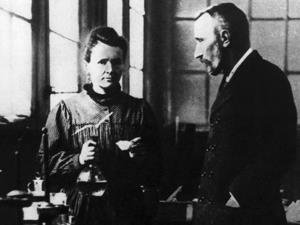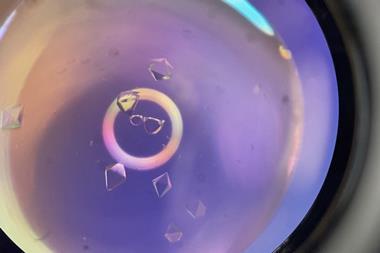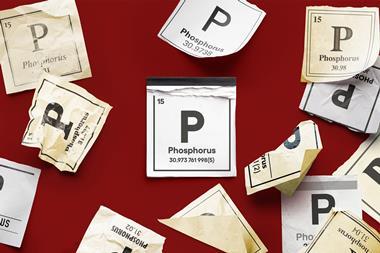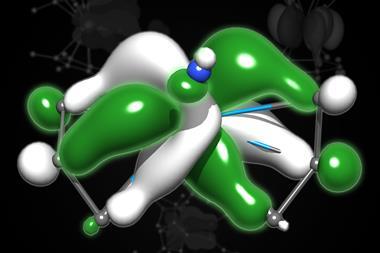Meera Senthilingam
This week, a glowing element that significantly changed the periodic table.
Richard Corfield
When I was a little boy my father used to tell a story about a acquaintance of his who kept a lump of rock in his desk. His party trick - after a few drinks - was to draw the curtains, touch the pebble to the forehead of a volunteer, turn out the light and lead the hilarity as the victim's face blazed with a ghostly blue light. Eventually my father's acquaintance died and his executor started to dispose of his possessions. Finding the lump of rock in his desk, and noticing the sourceless dull blue glow that surrounded it he sought advice. Within hours the house had been sealed off and men in white environment suits with tongs and a lead box were relocating the magic pebble to the Atomic Energy Research Establishment at Harwell in Oxfordshire, the secret hub of Britain's nuclear research and development industry from the end of the Second World War to the 1990s.

The pebble was, of course, pitchblende; the naturally occurring mineral that Pierre and Marie Curie had used as the source of the radioactive elements that they discovered in the closing years of the 19th century. Pitchblende does not just contain actinium (the topic of this podcast), it also contains radium, radon and polonium; the latter, if we are to believe recent news reports, the Russian assassin's toxin of choice. Actinium, like radium and polonium, emits an ethereal blue radiance which contributes to pitchblende's luminescent properties. Although, radium, radon and polonium were observed first, of all the components of pitchblende actinium was the first to be isolated.
Actinium was discovered by Andre-Louis Debierne, a friend of Marie and Pierre Curie who worked with them on isolating the radioactive elements in pitchblende. Although he published descriptions of the element in 1899 and then again in 1900 there is some doubt as to whether his techniques had actually allowed the element to be properly identified. What is clear however, is that the German chemist Friedrich Oskar Giesel was also investigating actinium and, by 1904, had unambiguously isolated it. Because of the glow that emanated from it he named his new element emanium. Giesel was an admirer and loyal supporter of the Curie's and consequently was not interested in disputing the priority of discovery of a radioactive element that had come out of a lab whose work he admired hugely. Hence when it became clear that Debierne and Giesel were working on the same element Giesel was content to allow the Frenchman's claim to priority stand, and so today the element is still known by the name Debierne gave it - actinium.

Whoever discovered it, actinium has an important place in the history of chemistry. It was the first of the non-primordial elements to be discovered. Primordial elements are those that have existed in their current state since before the Earth was formed. In other words their half-life is greater than about 108 years. All stable elements are primordial, as are many radioactive elements. Chemically, actinium, which in its native form is a silvery metal, has similar characteristics to that of the other rare earth elements such as lanthanum.
Actinium has thirty-six isotopes all of which are radioactive. 227Ac, the isotope which comprises all naturally occurring actinium has the longest half-life at 21,773 years. All the remaining radioactive isotopes have half-lives of the less than ten hours, the majority having half-lives of less than a minute.
227Ac is about a hundred and fifty times as radioactive as radium making a valuable as the neutron source of energy. Although actinium is found in trace of amounts in uranium ore, more commonly it is synthesised in milligram amounts by the neutron irradiation of radium-226 in a nuclear reactor.
Actinium gives its name to a block of fifteen elements that lie between actinium and lawrencium in the periodic table with atomic numbers 89 through 103. These actinides - or actinoides as they are more correctly known these days - gain their name from the first element in the series, actinium, itself named after the Greek word for ray thus reflecting the element's - already mentioned - visible radioactivity.
The actinoides were the first major addition to be made to Mendeleev's periodic table. American physicist Glenn T Seaborg was experiencing unexpected difficulty isolating the elements americium and curium during his work with the Manhattan Project during the second world war.

He found himself wondering if these elements more properly belonged to a different series from the transition metals, which would explain the differing chemical properties of the new elements he was synthesising in the nuclear reactor at Berkeley University in California.
In 1945, Seaborg formally proposed the actinides and in so doing created the most significant change to the periodic table since Mendeleev's creation of it in 1869.
Early in his career, Seaborg was a pioneer in the study of nuclear medicine and developed numerous isotopes of elements with important applications in the diagnosis and treatment of diseases, most notably 131Iodine which is used in the treatment of thyroid disease. Actinium also has a role to play in nuclear medicine. 225Ac can be used as the active agent in Targeted Alpha Therapy (TAT) a technique for inhibiting the growth of secondary cancers by direct irradiation with nuclear material, in this case 213Bi derived from 225Ac.
And so an element discovered in the same mineral - pitchblende - which kick-started the whole science of nuclear chemistry, today stands at the crossroads of one of the most challenging of all medical disciplines - finding a cure for cancer. The irony is that pitchblende inflicted a dreadful toll on those who worked with it in the early years of the study of radioactivity. Marie Curie suffered terrible radiation burns from handling it, and eventually, in later life, contracted radiation-induced aplastic anaemia from which she died. Even today Marie Curie's papers from the summit of her career in the 1890s - including her cookbook - are still considered too dangerous to handle, and are kept in lead-lined boxes
Meera Senthilingam
So whilst offering hope for treating the deadly effects of cancer, the element itself had deadly effects on its founders and therefore must be handled with care. That was science writer Richard Corfield with the radio active chemistry of actinium. Now next week we go beyond the actinides.
Simon Cotton
When the last member of the actinide series, element 103 or Lawrencium, was discovered, I was at school doing my A levels. The isotope found had a mass of 258 and it didn't hang about for long - it had a half-life of just 3.8 seconds. This was not unexpected as half lives had been getting shorter right along the actinide series. This discovery prompted the scientific community to start asking, are there any elements waiting to be made beyond Lawrencium, and if so, where would they fit in the Periodic Table?
Meera Senthilingam
Join Simon Cotton to find out how element 104, Rutherfordium was discovered and how its place in the periodic table was found, in next week's Chemistry in its Element. Until then, I'm Meera Senthilingam and thank you for listening.













No comments yet